BURNIE PRINT PRIZE 2023
JULY 21 - SEPT 8
 Cleo Wilkinson - Encounter
Cleo Wilkinson - Encounter
Welcome to the Burnie Print Prize 2023
After several tumultuous years globally and also here in Burnie it feels right and reassuring to once again be presenting our biennial Burnie Print Prize exhibition in the Burnie Regional Art Gallery.
It is pleasing to note that this year, the ninth Burnie Print Prize, is a record year with 185 entries received and I would like to acknowledge and thank all of those artists for submitting these entries, thereby signalling their ongoing support for this national prize. From those 185 submissions our judges selected 66 works for exhibition and from those works will choose an outright winner who will receive the $16,000 acquisitive prize, our biggest prize to date. In addition to this major prize, this year, we have inaugurated a non-acquisitive emerging artist prize of $5,000 through which we hope to encourage the growth of the printmaking sector with a clear incentive for new and emerging artists to participate in a prize like this. As in previous years, a people’s choice prize of $1,000 will be voted on by visitors to the exhibition.
The Burnie Print Prize was first established in 2007. It has grown since that time to become one of the major national prize exhibitions for printmaking in Australia. The prize has contributed significantly to the reputation of Burnie’s cultural scene and has impacted positively on the growth of our City’s permanent art collection.
Looking ahead now, with half our building currently a building site at the time of writing this introduction, it is exciting to think that in a little over a year we will have a reimagined cultural centre, fit for purpose for the next 50 years, with our art gallery and our art collection at its heart.
A special thank you goes to our 2023 judges Annika Romeyn, Ashley Bird and Milan Milojevic. I must acknowledge the important ongoing financial support received from Burnie City Council and Arts Tasmania without which a prize exhibition like this would not be possible. Thanks also to our new and enthusiastic Museum and Gallery team here – Curator Laura Courto and Collection Officers Allison Campbell and Jason Ball. Finally, a big thank you to the many Friends of the Burnie Regional Art Gallery who have supported our community’s art gallery through the good times as well as the bad and continue to campaign for art, culture and creative activity in the heart of our fine City.
Mark Viner Executive Manager
A curatorial snapshot
As a city with a rich papermaking history, Burnie has long embraced the art form of paper based printmaking. Recognising and promoting an appreciation of the medium, the Burnie Art Gallery celebrates the expressive possibilities and high level of craftsmanship involved in contemporary printmaking practice.
Since its inception in 2007, the Burnie Print Prize has quickly evolved, reflecting the continuing development of the printmaking medium. Moving beyond the misconception that printmaking serves only as a means of reproduction, the 2023 prize exhibits a number of unique or single edition works. The exhibition also highlights an array of both traditional and modern printmaking techniques from woodcut, etching, lithography, and engraving, to contemporary digital printmaking practices.
Artists from all states and territories are represented in this exhibition, 19 from New South Wales, 17 from Tasmania, 14 from Victoria, 7 from Queensland, 5 from the Australian Capital Territory, 2 from Western Australia, and 1 each from the Northern Territory and South Australia.
I would like to thank our three judges, Annika Romeyn, Ashley Bird and Milan Milojevic for the time they have invested in the 2023 prize, particularly during the pre-selection process where they not only visually assessed each entry, but also read 184 artists’ statements and biographies. Out of this record number of entries, 66 works by both established and emerging artists were selected. The artists showcased utilise a diverse range of materials and techniques, exploring the endless innovation and possibilities of contemporary printmaking in Australia.
Laura Courto Curator Museum and Gallery
Burnie Arts acknowledges with deep respect, the traditional owners of the land lutruwita (Tasmania) on which we have the privilege to present creative programs
Alison Alder
The Rush That Must End, 2021
Screen print
76 cm x 56 cm
Edition 2/10
Printer - Trent Walter/Negative Press
In 1969 the British/American artist RB Kitaj, with printer Chris Prater from Kelpra Studios, produced a portfolio of fifty wonderful screenprints called In Our Time: Covers for a Small Library After the Life for the Most Part. The artworks were developed from the covers of books Kitaj found as he trawled through the second-hand bookshops on Portobello Road in London in the early 1960s. His selection of works reflect his interests at the time – literature, film and sociopolitical history, and his delight in both the texts and the graphics. I used to request these beautiful prints every time I took art school students to the National Gallery’s Collection Study Room as I loved looking at them so much – for both the ideas behind the works as well as their beautiful print quality. They are rich in every way.
My library includes books that I inherited from my parents and editions that I have collected from second-hand shops and book sellers, often purchased just because I delighted in the covers. As Kitaj stated in 1964, ‘Some books have pictures and some pictures have books.’ It occurred to me, not long after the catastrophic fires of 2019/20 and the tragic destruction of Juukan Gorge, that many of the volumes in my library needed updating to reflect what is happening in our country now. Geoffrey Blainey’s The Rush That Never Ended was an excellent candidate – for so many reasons.
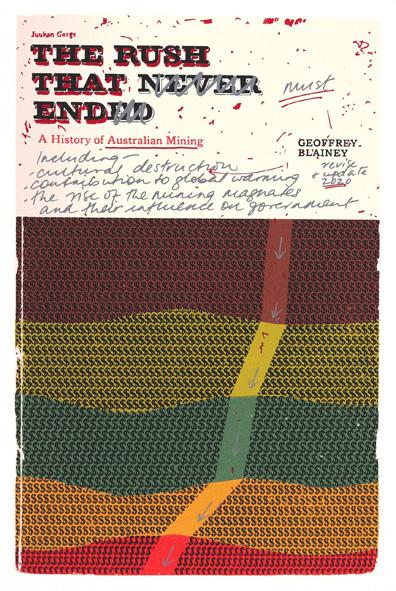
Tony Ameneiro
Nattai River Landscape
- Sloping Ground (Diptych), 2021
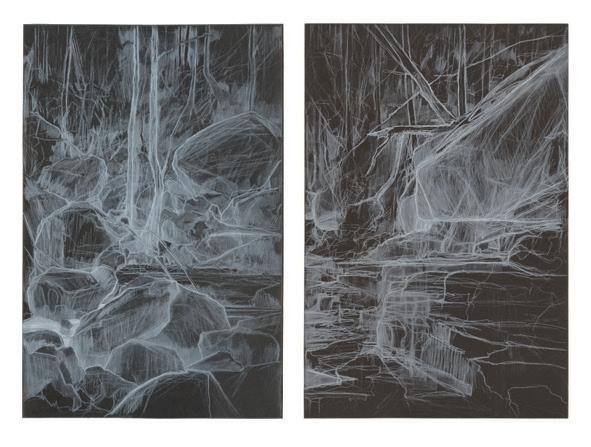
Drypoint in white ink with chiné colle
112 cm x 153 cm
Unique State
This print comes from a series of works done in an area close to my home in the Southern Highlands of NSW on the Nattai River. This area was visited by artist Fred Williams in August of 1957. Using sloping ground as a loaded term along with a reversal of tone to suggest an unsettling and possibly disturbed landscape.
Emma Armstrong - Porter
Breaking out of the Psych Ward to go to the Tote, 2022
Linocut
56 x 42 cm
Artist’s Proof/15
Lines carved into lino like ink into skin, this piece explores the use of tattoos as a form of autoethnography. The artist uses semiotics and symbols to create a narrative. Drawing comparison to prison tattoos, Armstrong - Porter speaks of institutionalisation in the Australian Public Mental Health system.
Cathedrals and Kremlins are tattooed onto prisoners’ bodies to indicate time spent incarcerated. In this case Melbourne Pub has replaced the church as a public landmark. The swallow tattoo traditionally symbolised a safe return home and speaks of freedom. This print was commissioned by the National Gallery of Victoria as part of their Melbourne Now exhibition, 2023.

Paul Bong Canopy Collision, 2023
Hand coloured intaglio etching & cholograph

120 cm x 250 cm
Unique State
This work brings together three episodes of a collision between two cultures.
The left panel shows Under the canopy, our shopping baskets. This work depicts the unmuddied arrangement of our daily lifestyle. Our tools and baskets used to gather and collect from this vast food hall, the Rainforest.
The centre panel 250 years of a dispersed and fragmented culture reveals the clamour of first contact. A whirling clash of weaponry and regalia with James Cook who first stopped in 1770. The large gathering shield is broken and disjointed showing the scars of combat including bullet holes. The etched circular rings symbolise the call of the tribes. Ceremonially we regularly gathered, shared dances, gifts and all went home. The dispersed fragments and broken shields represent what has been ripped away leaving a displaced culture and remnants of language.
The right panel, The day the flag came into our country shows the persistence of the colonisers. Regal colours sharply contrast the natural colours of the rainforest canopy. Britain, unknowingly to us, had staked a claim. Decisions were made without any discussion or treaty with the landowners. Queen Victoria and the Union Jack now dominate the form and face of our shield. It protrudes over our King, my great-great-grand dad. His ownership has been overshadowed. To the onlooker, it’s confusing. That is how it was for my people who have been scattered and displaced when these people and new laws came, never to leave.
Deidre Brollo
Unsettled, 2022
Artist’s book (screen prints, archival pigment prints, laser cuts)
33.5 cm x 21.5 cm
Edition 6/8
The artist’s book ‘Unsettled’ considers the motivations and consequences of topography and toponymy – of place-writing and place-naming – and explores how language, ink and paper have been used as colonial and bureaucratic tools to shape, control and ‘settle’ zones of upheaval.

Drawing together thousands of contemporary Australian place names, the work reflects on the many acts of imagination or memory that collectively wrote over this landscape, inscribing the map with traces of emotion, bewilderment, violence, subjugation, opportunity, and failure. The work also incorporates satellite imagery centred around Mount Delusion, which has been disrupted through deliberate error and mis-registration. These maps, then, allow no comfortable point of viewing, but rather leave the viewer adrift and disoriented.
In pulling against the organising principles of cartography, the work seeks to disconcert, to discomfort, and to disorganise a ‘settled’ view of place. Visually unstable and cartographically disrupted, Unsettled speaks to the unfinished and restless nature of this country and its history.
Laura Castell
Bark Landscape, 2023
Monoprint multiple layers
150 cm x 56.5 cm
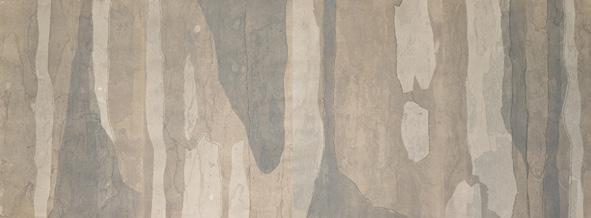
Unique State
This work reflects a recent journey into abstraction. It is inspired by the world of the tree barks I encounter in my walks. My aim is to capture the essence, the simplicity and richness of this landscape. Through a process of selection of colours, patterns and textures, printmaking techniques are used to transform the image in an abstract form that remains identifiable. There is an intention to inject the feelings of calmness, awe and beauty I experience in my contact with it.
Seong Cho
Terrestrial Symphony III, 2022 (Detail)
Multi woodblock print
61 cm x 264 cm
Edition 1/2
This work represents the feeling of being immersed in the depths of a native Australian forest, lost within tangled vines, damp green moss, brown undergrowth and thick tree trunks soaring up into the sky. It is inspired by recent long walks in the ancient Gondwana rainforests on the NSW Mid North Coast, which are under threat from further bushfires and logging.
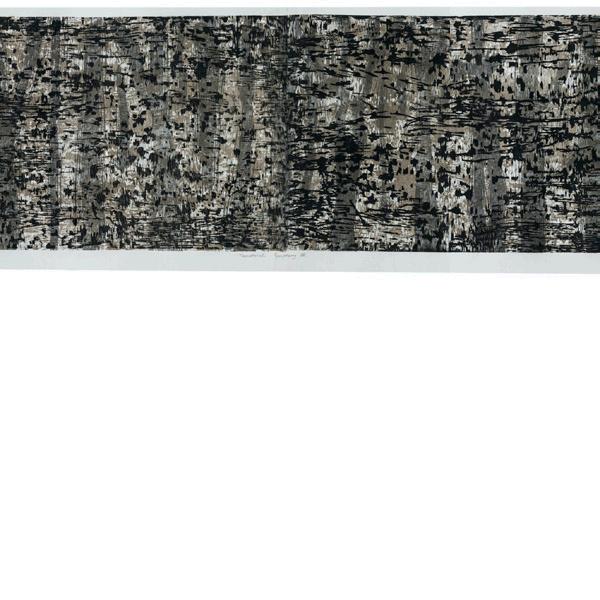
The large scale of the work represents the hypnotising endlessness of the forest, the sense of movement and symphony of sounds that echo around you and help you escape from reality. I wanted to convey the beauty of our natural environments and importance of protecting them from commercial, industrial and climate-related destruction.
This work invites viewers to think of the forest and ask themselves the question: What kind of world do you like to keep?
Matthew Clarke
Art Bird, 2023
Linocut
39 cm x 34 cm
Edition 2/12
Printer - Glenn Morgan
This print is a 3-colour linocut titled ‘Art Bird’. I partner with my friend and mentor Glenn Morgan. Glenn talks me through the process. I cut the whole linocut then the linocut is cut into three panels and they are printed individually one at a time in different colours on the same paper to make up the coloured print.
The inspiration for this print is my love of birds in their natural environment

Neilton Clarke
Striation Station, 2022
Woodblock print, screen print, collage
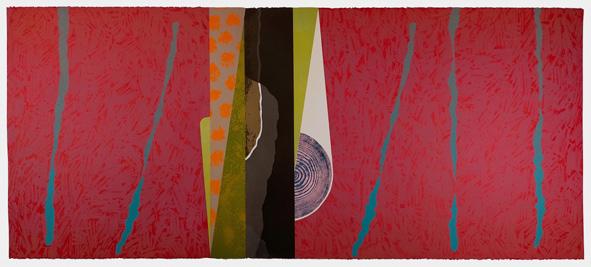
73 cm x 146 cm x 5 cm
Unique State
The woodgrain impressions making a cameo appearance here are, for me at least, synonymous with the cedar and pine-clad mountains of the Tokyo-Yamanashi border realm and whose seismically prone inclines I’ve made countless excursions on. Their striated contours, echoing summer-winter growth accretions and making for a logbook of a tree’s growth, figure as end-point attractions and as metaphors for a broader range of phenomena.
Ange Cooper
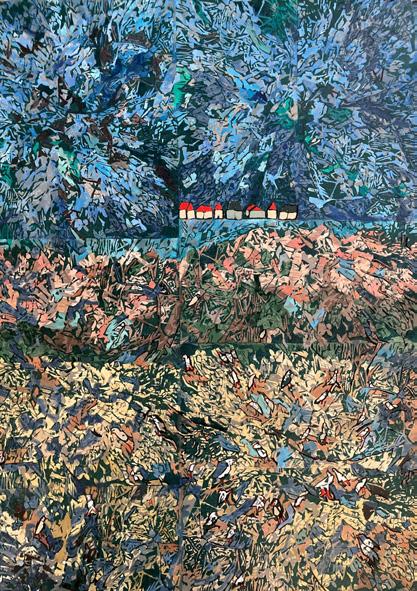
Chaos, 2022
Linoleum
84 cm x 64 cm
Unique State
CHAOS
Chaos and beady eyes and filed footsteps dotting over walls you can’t even see, that see us all and leave.
Red jagged edges and coarse yellow and white. Violent and creeping and groaning.
But you itch and you scratch and come home again. Because it’s safe where it’s coarse and nice where there’s chaos.
Rebecca Coote
October Sunrise 2022, 2022
Hand coloured multi plate drypoint
60 cm x 60 cm
Unique State
Did explorers and mapmakers view the new lands they visited through their own lens of perception? Were their observations affected by the shifting timeframes and weather patterns of the day or season? If I were to create a map of my local landscape how could I not make it subjective?
My work aims to speak of the transitory and ephemeral nature of the landscape that surrounds my coastal home in southern Tasmania. Exploring what it is to be present in the landscape, to feel the shifting tides, wind and rain. To feel how a time of day can evoke a strong response.
‘October Sunrise 2022’ captures the sun rising over Pipe Clay Lagoon where I live. I worked quickly to create the shifting landscape by using different printing plates that were shifted and spun, printed over and over to create a sense of movement and time passing. More colour was then layered by hand, rubbed off, and layered again – constantly shifting until I got the right feel for the morning.

Carlton Cox
Glasgow Engineering, 2021
Linocut
67.5 cm x 54.5 cm
Edition 13/20
A peek through a window at Launceston’s iconic Glasgow Engineering immediately grabbed my attention. I immediately set to work to interpret this bold industrial interior as a colour linocut.
‘Glasgow Engineering’ combines multi-block and reduction techniques with 7 colours. Created with oil-based inks and printed on BFK Rives 250gsm in an edition of 20.
 Danielle Creenaune
Danielle Creenaune
Luminous Fall, 2022
Woodcut
111 cm x 90 cm
Edition 5/10
‘Luminous Fall’ is my response to traversing local waterfalls on Dharawal country attempting to capture the nuances and significance of water. It follows the life-force and impact of water as a grounding influence of the land around me. I observe the different qualities of water - movement, light, strength, fluidity and flow. I am interested in ways to represent the mass and substance of water and the opposing solid but fluid qualities through the medium of print.
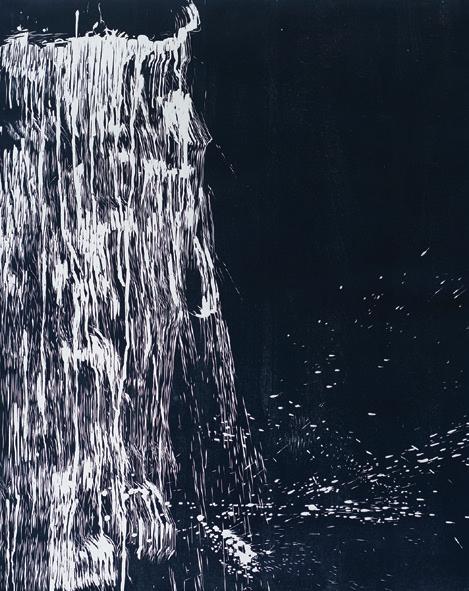
Lana de Jager
Repose, 2022 (detail)

Solarplate Etching
149 cm x 76 cm
Edition 10/20
With this artwork, I wanted to capture a moment of tranquility after working very hard to be ‘relevant and productive’ during the pandemic. My brother, a painter who usually lives in Barcelona and who has always been known as the “Carl cat” in our family, lived with me through the Victorian lockdown, for the first time since we were students in the 1990s. Living together for 18 months as adults during the heightened anxiety of the pandemic was wonderful for our art and for our connection as siblings, but we also had some dark and heavy times. Our childhood story was overlaid onto our adult story in a way I could only describe with an image. This is a moment of rest before, once again, on opposite sides of the world, we start wrestling with the beast that is creativity.
Pauline Denney
Woven Women, 2021 (Detail)

Solarplate Etching
78 cm x 193 cm
Edition Unique State
Made up from several different colours that made up a cheerful summer look and was taken from an old solar plate that was left to me from a print maker getting rid of her supplies she no longer wanted, cracked plates that would have been thrown out. I decided that I liked the old look of them still and went ahead and used them as an art work that took some time to produce. The solar plate is used with my life drawing figures that I kept over the years of drawing at a group on the mainland NSW.
Sitting - is the name I called the original Solar Plate that is made as a single item from sunlight and acetate with my life drawing figures, women in different positions.
Weaving the image came from the form of basket making, which I enjoyed, learning here in Tasmania. Cutting up the print work and putting it back together in a different form is a bit like collage and cutting up ones own art work was great to let go of it and take it to another form.
Jacqui Driver
Where Weeds Dwell, 2022
Lithograph
224 cm x 152 cm
Edition 1/3
‘Where Weeds Dwell’ Driver sees as reflecting her experience of complex mothering. The rocky cavern beneath the thicket of weeds represents Driver’s emotional experiences of living with anxiety, mothering, and Rheumatoid Arthritis. Learning to cope with the complicated mental health needs of her children, without triggering her own anxiety, is reflected in the tangle of weeds which grow like a thicket over the rocky terrain. Those interconnected strands act like a protective layer at the same time as entangling and ensnaring their host. A mother is, after all, permanently attached to her children despite at times feeling overwhelmed or even ambivalent.
‘Where Weeds Dwell’ masks the pain of transgenerational trauma within its beauty as successfully as the body masks the pain of difficult mothering experience.
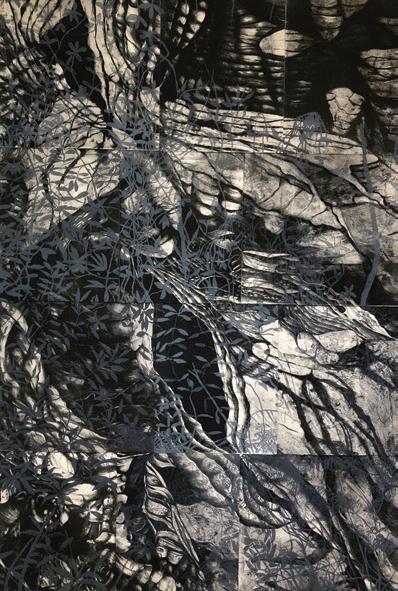
Rachel Dun
Fieldnotes 2, 2022
Etching, Woodcut, Embossing, Dragon scale artist book
17 cm x 57 cm x 2 cm

Edition Unique State
I am fascinated with the macro landscape and all the microcosmos that make up the ecosystem. By living slowly within nature, the concealed is revealed, gifting inspiration in every aspect. As an artist I have a responsibility to portray nature so others value and protect its fragility. In choosing the dragon scale fold for my artist book “Fieldnotes” as a metaphor for nature as it is also fragile and endangered.
Erica Elgin
Spur, 2023
Multi-plate aquatint
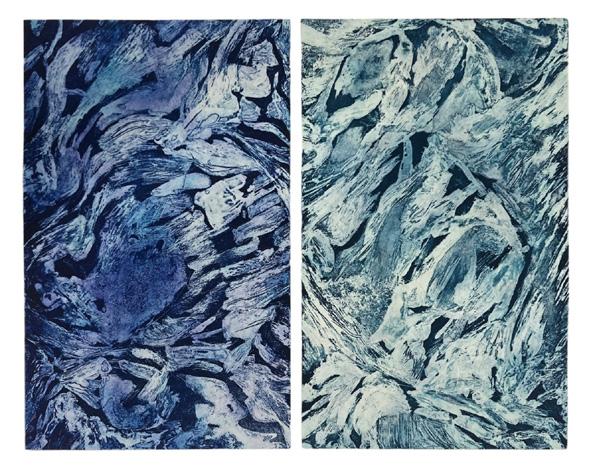
60.5 cm x 60.5 cm
Edition 1/16
‘Spur’ explores and expresses the profound emotive reactions experienced when attuned to the captivating details of nature. This rich celebration of the texture, movement and colour of botanical specimens aims to extend the viewer’s perspective from seen to sensed in order to invite a deeper appreciation of the natural world. The significance of plant life’s presence is brought to the forefront by calling on and expressing deeply-felt emotive responses to the awe-inspiring beauty of flora. Intuitive and emotionally-charged reactions to details of living botanical specimens are the impetus for this multi-plate etching, following attentive observation. These recorded sensations and impressions create an abstract landscape of raw emotions, with rich and varied colours integrated with gradients and distinctive textures. Elements of living matter are captured and refracted through highly meditative and contemplative intaglio techniques in a sequential multi-plate process. This amalgamation of multiple plates — in which the image emerges through stages of increasing development — recalls the growth and temporal processes of a plant’s life-cycle.
‘Spur’ celebrates botany,employing painterly subjective representation to induce a shift in perspective towards curiosity and intuitive attachment. This, in turn, encourages further compassion and deeper connection to the presence and meaning of botanical species within the wider ecosystem. Ultimately as a passionate and subjective representation, ‘Spur’ strives to connect the viewer to our vibrant andvulnerable plant life to increase appreciation of the vital presence of flora and bring awareness to an often-overlooked earth.
Kristen Flynn
Self-portrait with grevillea, 2022
Oil on Fabriano paper
- solar plate etching
38.5 cm x 27 cm
Edition 2/10
‘Self-portrait with grevillea’ (2022) was created using digital photography, solar-etching techniques, and a printing press. In my work, the grevillea’s stem mimics a spine-like structure running through my face showing what seems to be my internals. My flesh becomes the flower and the flower becomes my flesh. This is about coming-to-terms with my mortality and communicating this through a found object, in this case, a flower. My portrait acts as a mirror; I can stand in front of the artwork, and I see my reflection, contemplating what I can learn from it. I like to think of my self-portraits as the Australian-American author-scholar Ker Conway suggests, as a form ‘in which we report ourselves to ourselves’ (cited in Hershberg, 2020, p.77).
 Dianne Fogwell
Dianne Fogwell
Tempest, 2023
Linocut
142 cm x 152 cm
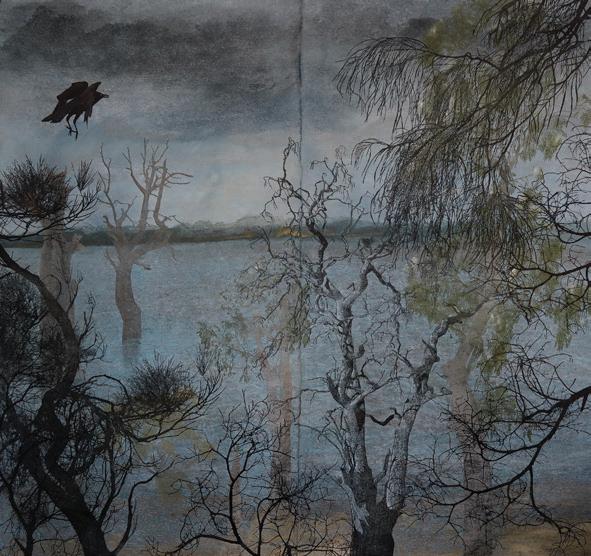
Edition Unique State
TEMPEST – is a contemplation on global recent floods, their beauty and destruction and ponderings on our ability to take up the challenge of climate change.
I remember Kati Thanda-Lake Eyre Basin flooding after four decades of drought and coming alive with colour and life. This year, near Canberra, Lake George called Weereewa, “bad water” in the local Indigenous language of the area has flooded and so full of water that the bird life is something to see.
Water is such a vital and stable presence in our world, so intrinsically connected to humans who are mostly made up of it. Necessary for agriculture, industry, power, residential needs, and our direct consumption yet we don’t seem to understand it.
The four principles about water discussed in debates globally are conserve water, reuse water, know where you use water, and continually evaluate how you use water and publications on climate change clearly state how far we have overstepped our footprint in these areas.
This makes me think and reflect on Plato and his writings on “Atlantis” in Timaeus, in 360 BC. Plato described Atlantis as a mighty civilization that became greedy and “morally bankrupt” until the gods “became angry because the people had lost their way and turned to immoral pursuits,” and as punishment, the gods sent “one terrible night of fire and earthquakes” that caused Atlantis to sink into the sea.
Fact or fiction, or is there a lesson there to think about.
Keryn Fountain
Eight Lines Falling, 2022
Tusche wash lithograph
78 cm x 53 cm

Edition 1/5
‘Eight Lines Falling’ 2022 was created using both hard and soft tusche wash that had been dissolved separately in water to make two dark washes that were texturally different. The concept for the idea was to discover how the chance merging and settling of pigments would appear when dropped across horizontal lines that were drawn with a water-laden wide brush onto a lithographic stone. The lines were drawn one after the other with the tusche applied progressively and allowed to flow from one to the next. Additional water and pigment were added to manipulate the wet image. Dried tusche washes can appear like the granular weathered surface texture of rocks, the visceral movement of light on water or windblown clouds.
‘Eight Lines Falling’ 2022 is a response to the changing nuances of light and shadow and the effects of weather on the surfaces of my outdoor environment. The work could be seen as the magnification of a rock surface, or it could be a cartographer’s geographical perspective of valleys, rivers and mountain contours seen from a great height. The rhythmic ebb and flow of the tusche washes falling creates the impression of interwoven, hardened, gritty, weathered sediment like the grainy local dolerite rock that dominates the local soil profile. I am drawn to textural details that can be seen as both microscopic and expansive and invites each viewer to look closely and interpret the spatial context with a curiosity that extends to the world around them.
Grace Gladdish
Summit 12, Pan, 2023
Hand Painted Linocut
75 cm x 145 cm x 5 cm
Edition 15/Variable Edition
‘Summit 12, Pan’ is part of an ongoing series of hand painted linocuts exploring the alpine environment at the summit of kunanyi. I live on the mountain and like many Tasmanians and tourists I make regular pilgrimages to the summit. Sweeping vistas, a vast sense of space, delicate and diverse plant life, and monumental rock formations create a stark yet subtle, harsh yet fragile place that seems to exist in the tension between its extremes.

I have been working almost exclusively with hand painted linocuts for the last few years. The combination of linocut and watercolour speak to a duality that I find in the alpine landscape. They give me the opportunity to combine the strength of the black and white linocut image and the subtlety and hues of watercolour. Oil and water come together to explore the polarities that make this landscape so appealing to me.
Complexity is one of the emerging themes of my alpine landscape series and I can see it in ‘Summit 12, Pan’. The sheer complexity of the alpine environment, the interdependence of the elements is arresting and compelling. The metaphor of the mountaintop references the idea of difficulty and complexity too - the climb being both as arduous and as rewarding as the carve.
Maximilian Gosling
Studies in Groovitation 2, rhythmic patterns E, G & J, 2022
Watercoloured etching
30 cm x 45 cm
Edition 2/2
The ‘Planting of the Drums’ is a ritual parade that takes place in the badger city of Madráyiss.
The parade starts when a drum that is ready to be planted is brought forward by a ‘Planter’.
The Planter is normally joined by their ‘Caller’, who starts playing an energetic rhythm on their drum.
This high energy rhythm attracts other drumming badgers and the group grows in size.
Not all the badgers play drums in the gathering, many will grab anything that makes a noise.
A common sight in these parades are the saucepan hats being hit with a soup ladle. These items (especially the soup ladle) are seen as symbols of unity and rebellion in Madráyiss. The group continues to grow in number as it moves through the tight streets. When the parade nears the planting place the volume becomes ear-splitting and the Planter comes forward to finally plant the drum at the spot.
This image ‘Studies in Groovitation 2, rhythmic patterns E, G & J’ combines three separate studies of parading Badgers. The aim was to try and capture a few of the contagious rhythms that are played in the parade. The image also uses the spaces between the characters (or no spaces) as a form of rhythmic notation, so the viewer can ‘read’ what is being played.

Kaye Green
Bonsai Pilgrimage, 2023
Lithograph & collage
80 cm x 90 cm
Edition Unique State/Varied
Printer - John Robinson
Moving Creature Studio
Fifty years ago I arrived home to Tasmania after having lived for a year in Osaka Japan as a Rotary exchange student.
I have been creating bonsai artworks to celebrate that extraordinary year and this “bonsai pilgrimage” has given me the opportunity for a deep reflective and meditative artistic experience.
Drawing each bonsai has been a spiritual experience each one giving me the opportunity to reflect deeply about Japan. Revealing the enigmatic qualities of the bonsai fitted perfectly with my feelings about Japan and my “Japanese ness”. Bonsai, for me, are about beauty, age, philosophy, time, memory, symbol and metaphor embraced in a small tree.

As a schoolgirl in Japan I loved studying the art of Japanese brush writing. I used to watch my teacher carefully; noting in particular how she held the brush and gently applied the ink to form the beautiful artistic writing. I was thinking of her as I applied the tusche washes to the lithographic stones hoping for that same gentle, flowing quality.
When I created the lithographs I used layers of collaged Japanese paper to emphasise the idea of time, memory and Japanese screens. I created the collage element hoping that the layering, composition and colour would add an extra nuance and depth to the work.
Rona Green
Lucky LeVon, 2021
Hand Coloured Linocut

57 cm x 76 cm
Edition 5/23
The pictures I make explore ideas about the nature of individuality.
Specifically I’m interested in how identity is expressed via the body; physical appearance and the ways it can be altered; the skin and its potential to be the stem point for transformation.
Use of tattoo as a motif is fired by its capacity to tell a story – it can convey information about origin, affiliation and proclivities. Tattoos can speak to (or be read by) everyone on some level which makes them an exciting tool for transmitting ideas.
The hybrid characters I create are loners, misfits and outcasts who bear the marks and scars of past experience. Through them I celebrate idiosyncrasy and uniqueness.
Jacqueline Gribbin
Hot Burn I, 2021
Water-based woodblock print (mokuhanga) on Tosa Kozo, with inks made from the charcoal of Stringybark and Woollybutt trees
44 cm x 58.2 cm
Edition 5/10
‘I live in a small rural community in the Northern Territory, which is subject to fires every year. Fires at the start of the dry season are ‘cool burns’, which are low to the ground and allow vegetation to regenerate. Uncontrolled bushfires or ‘hot burns’ come through the land late in the dry season, burning the ground, the undergrowth and high up the trees, leaving everything in its wake burnt black.
One month after a ‘hot burn’, I walked through the local bush with my brother-in-law and First Nations artist Dennis McCarthy. With his knowledge of collecting charcoal for making paint for didgeridoos and bark paintings, he led me to the charcoal of the Stringybark and Woollybutt trees, which I collected. I dried and ground down the charcoal to make ink with gum arabic and ground water for waterbased woodblock printing (mokuhanga), a printmaking technique that uses wood, handmade paper, pigment and water.’
By melding the printmaking and image making processes with the land, Gribbin lays testimony to her local bush in the Northern Territory being depleted by an ever-increasing number of intense fires each year, whilst also acknowledging the strength of the bush to try to keep regenerating.

Robert Hague
Christina (after Wyeth), 2022
Hand coloured lithograph on cotton rag paper
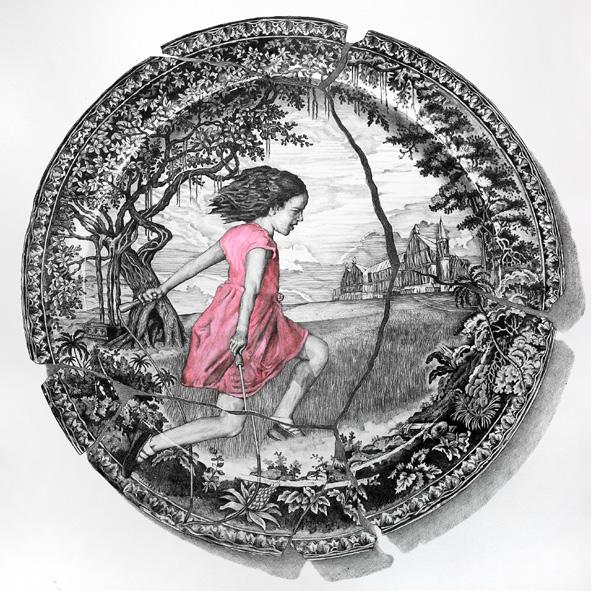
70 cm x 70 cm
Edition 2/25
The background for this composition is the iconic painting
‘Christina’s World’ (Andrew Wyeth, 1948), in which Wyeth depicts his neighbour Christina, who refused the use of a wheelchair, using her arms to drag her lower body along. “The challenge to me was to do justice to her extraordinary conquest of a life which most people would consider hopeless.” (MONA catalogue, 2019)
I have imagined Christina’s inner self, joyfully skipping across the field (Skipping Vinegar Girl, 1936), the farmhouse instead the Abbotsford Convent (an orphaned girls workhouse, Melbourne, 1863-1975) ominously wrapped by the contemporary artists Christo & Jeanne-Claude.
Christina’s leap is a symbolic step into adult life and mourns the loss of childhood. The scene is framed by a huge hollow tree.
Melissa Jean Harvey
Out to see(a), 2023
Pulp Print
42 cm x 29.7 cm

Unique State
‘Out to see(a)’ pulp print made from surplus QCA t-shirts was created while I was a guest artist in the Print department at Queensland College of Art, Griffith University in February this year. Holding inspiration from my immediate surroundings, both inside the papermaking studio and outside along the Maiwar River as I journeyed to and from the studio - I captured and recalled reflections of light on water, surface textures, and design elements that were visually immersive and at times surreal.
My practice is informed by an acute awareness for the global crisis of disposable fashion and its environmental and social impacts. I work predominantly in a medium that I produce from used clothing and domestic cloth donated by my immediate community. These articles hold stories and traces of their past owners embedded in the fibres. While bringing my own experiences, I acknowledge all these stories and combine them in a retelling through pulp prints that are meticulously layered and delicately sprayed textural wonderlands.
Nicci Haynes
The cost, 2022
Video from thermally printed
till receipts
Video duration - 3 minutes
Edition 1/5
‘The Cost’ is an experiment, as much about process as anything else. It was made at home during a COVID lockdown from phone footage of an empty shopping trolley being pushed around the suburbs with a receipt printer and a bundle of used receipts. Nothing happens. Nothing was happening.
 Dr Nicola Hooper
Dr Nicola Hooper
Pig man (H1N1), 2023

Lithography
120 cm x 90 cm
Edition 1/3
Pig/Boar/human mythical creatures exist in many cultures; historically, they have been used as signifiers to identify and warn of things or actions – using these creatures in the now acts as a metaphor to discuss contemporary concepts such as our anthropomorphism as we ingest animals as food or medicine and reflects the methodology of the work.
Using the Mythical ‘Pig man’ (H1N1) combines hand-drawn lithography and photography. The Manx cryptozoological creature and the now-extinct tusked Grice Pig inspired me to create this work. This work speaks of my background and makes associations through this creature’s hybridity to zoonotic pathogen transmission, human culpability in species extinction and negative impact on the world, and the evolution of new zoonotic viruses.
Fran Ifould
Homage to a New Dawn 2, 2023
Artist book of pokered woodblocks

60 cm x 120 cm x 12 cm
Unique State 2/2
‘Homage to a New Dawn 2’, made from hand coloured intaglio printed woodblocks of pokerwork, includes images of landform and Australian vegetation amalgamated into a fanfare of tribulation for our environment. We are living in uncertain times but as Benjamin Franklin once said “out of adversity comes opportunity”! That is the inspiration for this artwork. Adversity creates opportunities, and opportunities create destinies.
Bringing the woodblock into the covers of this book shows clearly the technique for making the printing plates. Plywood is engraved, mark making with a hot iron often directly from a forge, then shellac seals the surface ready to accept the process of intaglio, or relief printing.
Hahnemulhe cotton rag paper, 280gsm, is robust and sensitive to this process of printing and folding into sculptural forms. Jute thread, and features of St Armand paper from Montreal bring an element of internationalism, anticipating worldwide contemplation of innovation in how better to be stewards of our natural environment.
Sally James
Above and Below, Safety Cove, Tasman Peninsula, 2023 Monotype in Oil
95 cm x 74 cm
Unique State
I stood on the rock shelf watching the waves roll in, showing glimpses of seaweed in their curves before they broke; moving windows into the underwater world. The brief visibility of life underneath the waters’ surface made me aware of the vastness of the seascape just beyond my feet. How much more, I wondered, might we protect this underwater landscape if we could see its temperate rocky reefs and seagrass meadows spread out before us as easily as we enjoy a beautiful vista on land?
This spot on the northern end of Safety Cove beach, Tasman Peninsula, looks out upon a small section of where the giant kelp forests of Tasmania once flourished all along the east coast. Now only tiny isolated patches of this forest remain: victims of a spike in coastal ocean temperatures and the southward migration of the long-spined sea urchin that thrives in the warmer waters. All gone before most people even noticed, along with many of the fish and other species that relied on them.
In this artwork I blend an underwater perspective with the view from the Safety Cove rock shelf to depict the two linked landscapes of above and below.
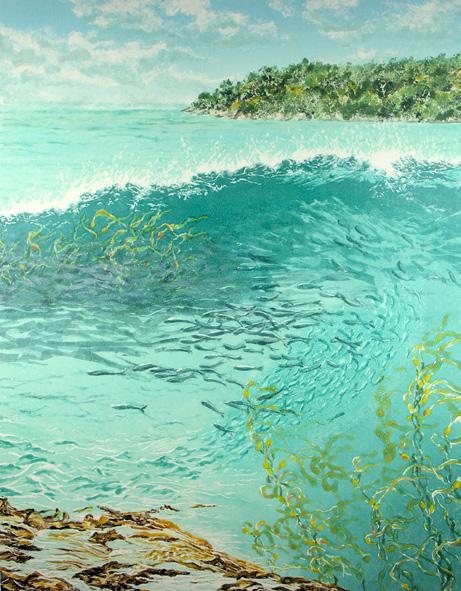 Lea Kannar-Lichtenberger
Lea Kannar-Lichtenberger
Natural/UnNatural – the cellular immersion of microplastics, 2023
Woodblock relief prints on rice paper and clear plastic in white and silver ink

240 cm x 100 cm x 60 cm
Unique State
A tsunami of plastic and its chemicals seeps into our biomass affecting all life. Evolution struggles to incorporate it; to make sense of this matter that has no nutritional value, as the plasticine era begins its domination of our microscopic world.
As these two worlds collide the historical evolution of nature with the new world order where plastic and microplastics are imbedding themself into our world on a cellular level, what will the outcome be?
In this work I examine the evolution of our cellular world. One stream the natural, cells on rice paper, the other cells on transparent plastic. Where they cross is vital for all survival on this planet. Will life continue to evolve and absorb this new toxic agent or will all life as we know it become extinct and disperse to evolve into something new?
Roslyn Kean
Crossings
- Sydney Harbour Bridge, 2022
Multi block woodcut, hand printed
55 cm x 122 cm
Edition 1/3
Since my 2 years of Graduate research on a Monbusho scholarship in Japan 1985-87 the focus in my work has been to employ all the elements of Traditional Japanese Woodblock techniques with a contemporary application. The layering of many blocks with exacting registration is essential to my work. Numerous blocks are hand carved, one for each colour and hand printed with a variety of barens on handcrafted Japanese papers.
“Crossings – Sydney Harbour Bridge” is a celebration of 90 years of service and the beauty of the harbour and the city surrounding the bridge. Every day is different capturing the light and colours through the steel structure of the bridge. From the bridge being bathed in early morning mist to reflections on the water and the glow of city lights shimmering through its structure.
This work constructed in 3D panels as a triptych represents the entry middle and departure of the bridge.

Virginia Keft Canopy, 2023
Silk eco-printed with Eucalyptus & Grevillea leaves found on Dharawal Country
200 cm x 210 cm x 210 cm
Unique State
‘Canopy’ is an immersive work that envelopes the audience in the imprint of Country. The work is a powerful statement about the importance of caring for Country and respecting the fragile ecosystem that supports us. The artist collects fallen leaves - and through a process of natural eco printing - she imprints silk with the colours and shapes of Australian native foliage. Hung together in the gallery space, the printed silk ripples and moves with the breeze and the passage of the viewer.

Eco printing is created by utilising the natural tannins and pigments in the leaves, seeds, and barks from Australia’s native plants. Leaves and plants such as Eucalyptus have been a rich source of colour for Aboriginal peoples for centuries. The artist’s process involves collecting fallen leaves and then encasing them in silk fabric and exposing it to heat - either through boiling or steaming in a pot.
The hues and patterns that emerge on the fabric and paper vary from clear, perfect imprints with sharp definition showing every line and leaf-vein, to abstract shadows and suggestions that merge in and out of the landscape on silk. The colours of Country that are permanently imprinted on the silk range from earthy browns, to sunset reds, rich rust, and surprisingly fresh greens. Each print is a unique celebration of the beauty of Country.
Jenny Kitchener
Seed totem II, 2021
Linocut with collage
56 cm x 93 cm
Edition 7/10
‘Seed totem’ is a three panel linocut with interlocking imagery depicting the unfolding journey of a seed from germination through to the production of blooms and then back to seed again. The imagery includes pollinators such as the bee, butterfly and bird, thus highlighting and bringing awareness to the alarming decline in numbers which is affecting so many of these pollinating animals which are necessary for the reproduction of many plant species and the biodiversity of our planet. The incorporation of an hourglass and a set of scales brings attention to the fleeting nature of existence and that time is fast running out to take action on our current environmental woes.

Cat Lawrance
Rendezvous, Interval Seven, 2021
Engraving, drypoint, dremel, aquatint, on copper plate, printed on Somerset
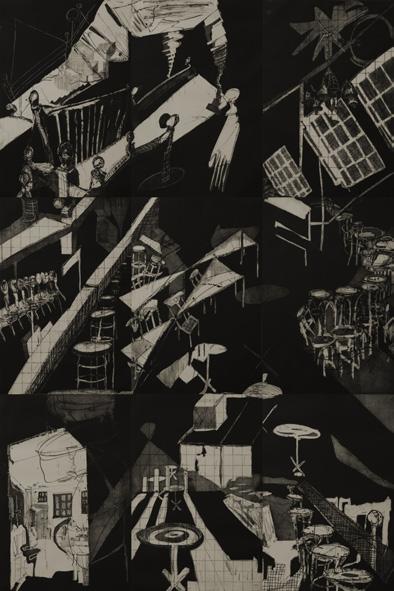
180 cm x 135 cm
Edition 2/3
‘Rendezvous, Interval Seven’ is the final stage in an iterative process and segment from the artwork Rendezvous exploring ‘parameters’, which Lawrance defines as limitations identified within processes that are perceived to hinder an outcome. The works draw awareness to the parameters within both printmaking and investigations of place, continually challenging them to seek unrealised potential. The copper plate is recognised for its reproducibility. However, within ‘Rendezvous Interval Seven’, Lawrance informs a play on impossibilities. Rather than disguising inherent variances or excessively attempting to produce perfect repetitions, Lawrance allows these differences to exist.
Lawrance visited three Melbourne pubs methodically throughout singular evenings, capturing a progressively chaotic image through sketching. An amalgam of printmaking processes is used to exaggerate the inevitable variances within each print and the natural shifts of the pub. As prints are pulled from each plate, viewers are invited to immerse themselves and discover the similarities and detailed fluctuating variances between each aquatinted plate, despite their identical undergoing.
Phoebe Lockwood At Your Service, 2022
Etching on Hahnemühle

20 cm x 20 cm
Edition 8/21
‘At Your Service’ combines the traditional print methodology of etching with contemporary practices of photography, bitmap and image transferal. The print seeks to anthropomorphise inanimate objects such as mannequins and household items into archetypes of domesticity. The etching plate has been blemished by an ineffective image transfer, soiling the idealism of the mannequin’s bodies with muddy marks that reflect the grime of domestic labour. These marks appear as ‘glitches’ in the making process, and are a divergence from the pristine and precise qualities often associated with etching.
Niloufar Lovegrove
Glorious Peace, 2023
Hand printed lino on Kitakata and Tengucho paper
206 cm x 310 cm
Unique State
The goddess like figure offering rebirth to the land beneath by lining up her extended determination with her pitcher of deed. The prosperous land behind her victorious steps, can see the harmonious people enjoying their glorious life in acceptance of the wise and humble leader.
This 16-panel piece is honouring the uniting will of the brave women and people of Iran in attempt to reach a jubilant living in agreement and peace on a land that is boastful of wealth.
 Monika Lukowska
Monika Lukowska
Monoliths, 2023
Digital print
86 cm x 120 cm
Edition 1/3
Printer - Rappid
The work ‘Monoliths’ is inspired by the landscape of Greens Pools in Denmark, WA. I was drawn to million years old rocks, granites, and dramatic coastal landscapes formed during the collision of continental masses. I consider those formations not only as invaluable parts of the environment but as elements that “tell” stories. Almost like palimpsests they retain layers of local history, and geological data and hold spiritual significance for the Noongar people. Through creative practice, I engage with their materiality and gradually unravel their entangled complexities and hidden meanings. The experiential knowledge of the place, gained through an active engagement with the sites, is then translated into artworks that aim to emulate the close connectivity of the body and place and to flesh out the place’s tactility and highlight its importance. The work aims to evoke the feeling of awe, deep time and of geological past embedded within the rocks.

Meredith Macleod
Shadowed by the Theatre of Life, 2023
Intaglio etching & aquatint

121.5 cm x 247 cm
Unique State
A reflective consideration of the loss of identity as one ages.
Annoying as it is to be overlooked, over corrected or ignored due to one’s age and gender, it can on the other hand allow one to drift in and out of life’s dramatic theatre unnoticed. This in itself can provide an immense sense of freedom. I may be vanishing…my shadow is not. I am now a silent observer in the emotional game of life.
Emma Magnusson-Reid
Stargazer, 2023 (detail)
Monotype on Hahnemühle Paper
90 cm x 118 cm
Unique State
‘Stargazer’ is a monotype print made using Scottish thistle seed heads collected from the nature conservation area near my home in Beechford, Tasmania. The print depicts a night sky filled with emerging stars, delicately crafted with a high-pressure etching press. Through this work, I contemplate the changing ways in which we view the night sky due to factors such as light pollution and the proliferation of satellites and space stations.

As an artist who also practices sensory deprivation floats, I draw a parallel between the pattern of darkness in the float tank and the vastness of the night sky. Both allow us to look inward and connect with ourselves. However, the night sky is rapidly changing, much like the evolution of our species. It feels as though we are at a tipping point where the touch and impact of humankind is pervasive and inescapable.
This work also represents my Tasmanian colonial history, as the thistle symbolizes Scotland and my ancestors who were Scottish convicts. It speaks to the ongoing presence of colonialism and its impact on the environment.
For me, the act of stargazing remains a symbol of hope and curiosity. Looking to the stars links us to the history of our race and reminds us that without those who came before us and looked to the stars, we would be nowhere. ‘Stargazer’ invites the viewer to consider their own relationship to the night sky and our place in the universe.
Fred Magro
fairy Bower, 2022
Mixed media and lithograph

75 cm x 82 cm
Unique State
The hand coloured lithograph went through a very slow and complicated process, to better get to know the work.
Multiple stone drawings with tone and touche washes to achieve a fluidity and depth of field. Additional paper laminations were added to the perimeter, asphaltum and water washes. The work speaks of a place where water tips,pools and falls over a sandstone cliff and plummets down into a creek.Time presents itself slowly through the shushing of water breezes through the shadows, the dark spots between boulders, layer upon layer.The repetitive smoothing and blending of the marks begin to dissolve just as rocks erode,trees loose their branches, boulders are dislodged and we forget. The work seeks to reveal and conceal.
Dior Mahnken
Comfortable in my own skin, 2023
Image transfer and monoprinting

67 cm x 80 cm
Edition 7/10
As women we are bombarded with all sorts of media with suggestions on how to our improve ourselves in every aspect of our lives. This work uses image transfer from skincare advertising in vintage vogue magazines onto tissue paper which are then over printed using oil based ink in colours of skin tissue. My daughter in her 20s is just embarking on a career in the skincare industry and this prompted me as an ageing woman to think about what it means to age gracefully and what it means to be comfortable in my own skin.
Margaret Manchee
Outside Inside, 2023
Etchings, papier-mâché, copper leaf gilding

17 cm x 13.5 cm
Unique State
The circle motifs that recur throughout my work stem from my Indonesian and Chinese heritage. I am driven by the creative inspiration just as much as I thrive on developing technical skills to push the boundaries of different physical media. For me, making art is a form of meditation. As I make the papier-mâché bowls, I can “see” the thoughts circling in my head. The work “Inside & Outside” reflects my practice of non-dualistic mindfulness. It is also in memory of my maternal grandmother who was a Buddhist. The text is an extract from “The Smaller Sukhavati-Vyuha Sutra”. Our family chanted the sutra for 8 hours after her passing. I enjoy working with Kozo paper because it combines flexibility with strength, characteristics which echo the fundamental “Yin Yang” principle of Oriental philosophy.
Jennifer Marshall
Turbulence –the elements in turmoil, 2021
Woodcut, etching

26.5 cm x 21.5 cm x 1.5 cm
Edition 4/4
The subject is the Four elements in disarray. The book is divided into 4 signatures corresponding to the 4 elements : in the order, Air (6 poems, 1 etching), Water (7 poems, 2 etchings), Fire (6 poems, 1 etching), Earth (7 poems, 1 etching) 26 poems by the poet published here for the first time. Poems handwritten by the poet in each edition.
5 original etchings (untitled) made by the artist to accompany Upcher’s poems plus woodcuts on covers and etchings for endpapers Jennifer Marshall has drawn and etched the etchings, carved the woodcuts, and printed them. The endpapers represent a person (maybe the poet, or the artist) overcome by chaos and printed as a negative. The cover image (both front and back , divided by the red spine) represents a turbulent wind blowing
Covers and endpapers relief prints on Zerkal laid paper 120gsm. Text is handwritten by the poet in pen and ink
Text and three intaglio printed etchings are on Somerset Book paper 115gsm. Two intaglio printed etchings and the papers separating the 4 signatures are on Hahnemühle Ingres grey paper 100gsm.
Printed by the artist at SeaFord Press, Adventure Bay, Bruny Island, Tasmania. Binding – books are hand sewn and bound 3 piece Bradel (cloth spine , no lettering) by Penny Carey-Wells.
Dianne Judith Masters
Undercurrent, 2022
Aquatint, etching, solar plate etching

206 cm x 310 cm
26 cm x 26 cm (closed)
Unique State
‘Undercurrent’, 2022 is a concertina artist book comprising sixteen multi-plate aquatint, etching and solar plate etchings of plankton printed larger than life to draw attention to that which is generally “unseen”.
This book is the result of several years of collaboration with scientists from CSIRO in Hobart. When first looking into the microscope of those plankton scientists, I felt like I was looking into “deep space” and have been working to replicate that idea in my print works.
Plankton are not only the start of the food chain but they fix carbon dioxide and produce half of the oxygen we breathe. Plankton are primary producers upon which all ocean life and our future depends.
The title ‘Undercurrent’ references both the ocean currents upon which plankton drift and the anxiety many feel about our future.
Cathryn McCarthy-Ross
Trout, 2023
Stone lithograph

50 cm x 70 cm
Edition 5/6
‘Trout’ is part of a stone lithograph series on childhood memories growing up on the NW coast of Tasmania. My family has a long pioneering history in the area and my memories are of quintessential NW coast subject matter and activities. My father and grandfather were intrepid hunters and fishermen who caught many fish in the lakes and rivers of the North West and West coasts. ‘Trout’ was inspired by a trophy fish caught by my father at the Pieman River in the 1980’s.
Lithography indulges my love of drawing, and using lithographic tusche washes and crayon to draw the textures and patterns of the fish I can explore and reconnect with those memories.
Paula McLoughlin
The dream #5, 2022
Screenprint
76 cm x 212 cm

Edition 2/3
The pandemic years were not a period of productivity, for this printmaker as it was for some, this artist found themselves in very different territory. So, in what was possibly a counter intuitive move, being unable to escape to the world of making and yearning for space I focused in and dreamt of clear horizons and big skies. I delved into historical travel, dreaming of open spaces, meditating on their grandeur. Even though there had been years of isolation there was calmness in the emptiness of the landscapes being revisited
‘The dream #5’ is part of a series of landscapes and memories of places once visited and captured with hopeful expectation. Landscapes captured so that there is a pathway back to the sensation of being there. Using these Images like a scent or a piece of music to guide a person back to the sensation of being in the open unencumbered, to feel the freedom and sense of place.
This print exploits the process of colour separation with the intention of creating differing layers and textures to bring depth and clarity. The hope is to give the viewer different planes of focus, the opportunity to stare into the distance or look through the textures through to in intermediate focal point. The purpose is always to be a bit dreamy and meditative.
Amy Morrow
The Big Tree Mawbanna “
Mayheyar”, 2023
Intaglio etched artwork
120 cm x 80 cm
Edition 2/2
Towering overhead the last generations, this magnificent 62m, 400 year old brown-top stringybark eucalyptus tree watches all, like an immovable sentinel, with its impressive 16m girth.
Established over 150 years before the first tall ships reached Tasmania’s shores, ‘The big tree’ will remain long after all who read this, have passed.
This work has been created on materials once destined for landfill. An offering if you will, out of simple respect to this majestic piece of natural history, it has been memorialised using discarded plastics. These have been etched, as an Intaglio print, with a focus on retaining the integrity of The Big Tree’s natural form.
 Helen Mueller
Helen Mueller
Forest Story 6, 2022
Woodblock prints on layered Kozo paper

104 cm x 180 cm
Unique State
I am a walker in forests, awed by their beauty and aware of the urgent need for human connection there so that we might value what we may very well lose without it. The question that arises, as I walk in these forests is how do I, as a recent arrival of European heritage, make this connection to forest lands, ones that have been trodden and tended for millennia by the indigenous peoples who walked here before me. This is a question that also underlies my work.
My searching for answers has led me to deploy the conventions of my culture’s dominant form of communication, and one that is implicit in my medium of choice, written language. With it I work towards an understanding. I have carved woodblock ‘phrases’ that I print over and over to track the rhythm, shadows and repetitions I observe when walking. They are printed on multiple, layered ‘pages’ and become a book-like story - my story about being in forests and seeking a connection there. There is an emphasis on material and process in the making of this work. And like a story, it takes shape in the thinking, remembering and in the doing.
I have found that this way of working has led to a shift away from the gaze towards immersion. I hope this Forest Story conveys something beyond the act of looking at a forest towards a greater sense of being in it.
Katie Paine
A beguiling congregation, 2022
Eucalyptus solvent transfer on archival paper
46 cm x 300 cm

Unique State
‘A beguiling congregation’ is an installation comprising a eucalyptus solvent transfer print, presented as a large scroll, originally made for the exhibition Venus in Tullamarine at George Paton Gallery. For the exhibition I was invited to respond to Melbourne University’s collection of prints by Norman Lindsay. The work considers Lindsay as an idiosyncratic, mercurial figure within the field of Australian art and the archival politics of his bequest to Melbourne University. The scroll displays printed facsimiles of archival images. Additionally, the work references the politics of image dissemination: information can become warped and obscured by time, the context of images and their meaning lost.
In the same manner these prints sit in a hybrid space between the photocopy, the print and frottage, the uniform treatment of each image invites audiences to consider Lindsay’s oeuvre in a broader sociohistorical context. It disseminates Lindsay’s etchings and political cartoons amongst the work of other artists working at the turn of the 18th and 19th centuries who also perpetuated a myopic, anglicised vision of the Australian landscape as a classical utopia. These are bewitching tableaux of forests populated by bacchanalian gatherings of fawns, nymphs and demons; fantastical images that mask the monstrous face of colonisation. A self-proclaimed anti-modernist, Lindsay produced romantic, theatrical images that sat at odds with the cultural climate within which they were made. This work focuses on the astounding anachronisms of his work and positions Lindsay as a strange jester or Peter-Pan like figure perpetually turning backwards to the past.
Ben Rak
Second Nature, 2021
Acrylic, silkscreen, stainless steel
eyelets, un-stretched canvas
140 cm x 110 cm
Unique State
Masking is a process which is intrinsic to the print. Masks control the flow of information from matrix to substrate. The metaphorical masks we wear function similarly - enabling us to manipulate our image and control the impressions other people have of us.
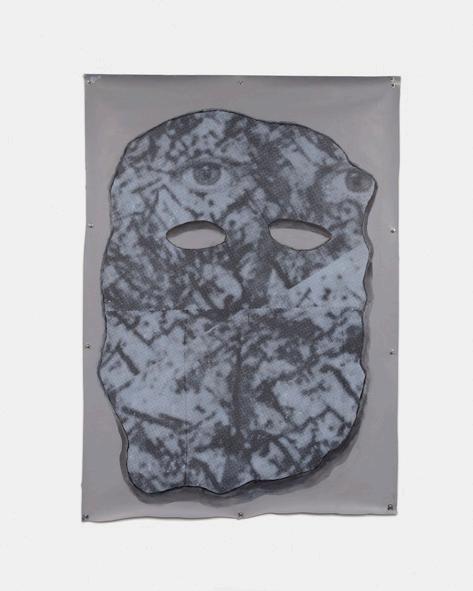
Yvonne Rees-Pagh
Ratatouille and the Cat Demon, 2023
Woodblock and screenprint
160 cm x 120 cm
Unique State
In the garden outside my back door a family of rats have made their nest. The family consists of a huge battle scarred male named Ratatouille, a female and her six babies. They come out at dusk and feed on scraps of food I leave out, Ratatouille usually stands guard while his family eats and run around.
This mischief of rats reminds me of a Japanese Ukiyo-e woodblock print by Utagawa Kuniyoshi titled Ghost of the Minister of the Left Michihira 1849. In his scene Kuniyoshi depicts a huge ghost rat in the background with a lot of smaller rats scurrying around a Samurai and a wise old man. In Japanese mythology animals are often depicted with human attributes or as ghosts and demons. In my print titled ‘Ratatouille and the Cat Demon’ I depict Ratatouille as an ominous big rat and unafraid of the cat demon looming above him. My cat and visiting cats do not go near him, only watch him from a distance.

My print was created using large hand carved woodblocks layered with screen printed imagery.
I know Ratatouille and his family are a common species of rat and opportunistic survivor’s but having watched them I find their behaviour to each other quite endearing.
Trudy Rice
Golden flower bloom
(Anthochaera Phrygia Regent Honeyeater Critically Endangered), 2023
Multiplate solar etching and monotype

104 cm x 104 cm
Unique State
A celebration of the beautiful Regent Honeyeater and its precious habitat.
“I love to walk in the bush and stand and listen. Often the birds take a while to settle, enough for me to catch more of a fleeting glimpse. I find a contemplative joy, that sigh of relief that I’m again one with nature.”
As I explore the delights of our natural world, I predominately use environmentally friendly and recyclable materials in my art practice, protecting the environment I love to encapsulate.
With mindful observation, I take initial drawings and create solar plate etchings which use the sun and water that my specimens are found.
Golden Flower Bloom is the English translation of the ancient Greek Anthochaera Phrygia or Regent Honeyeater. This beautiful Australian native bird is critically endangered, and the species is considered to be facing an extremely high risk of extinction in the wild.
Once found from Rockhampton to Adelaide but now confined to Victoria and New South Wales, this striking bird can be found foraging in eucalypt forests and woodlands.
Habitat loss is the main reason for the downturn in populations of the Regent Honeyeaters and many other small native animals.
Jenny Robinson
Paradigm #2, 2021
Drypoint on gampi tissue
152.5 x 203 cm

Edition 1/2
Robinson’s work is concerned with the peculiar transience of our man-made environment. She is specifically preoccupied with the conceptualization of ideas around fragility and strength, and in exploring the juxtapositions between the impermanence of what is ostensibly permanent. Her work can often depicts the entire timeline of a structure in one image, and by extension, that of the people who built it, used it and will take it apart – our past, present and potential.
Robinson’s practice emerges from the observation and study of the architectural fossils of the places she has lived. Through firsthand observation, she creates human-sized, two-dimensional representations of three-dimensional spaces that frame, and inform, the contemporary urban experience.
Increasingly inventive in her methods and her consideration of materials, her large-scale dry points are printed on lightweight Japanese paper, a material choice that points out the ironic contrast between the inevitable destruction of the welded metal building and the museum-conserved future of its likeness, pressed into semitransparent tissue.
These images are a carefully-constructed first-person record of a temporary place at a fleeting moment in time – an artist’s multilayered lightfast impression of impermanence.
Olga Sankey
Seeing Red: Plague, 2023
Boxed set 10 digital prints with embossing

44.5 cm x 31.5 cm x 3 cm
Edition 1/6
‘Seeing Red: Plague’ is a boxed folio of ten digital prints representing the ten plagues inflicted upon the Egyptians by the god of the Israelites, as described in the Book of Exodus in the Old Testament. As each horror is unleashed upon the land of Egypt, the Pharaoh promises Moses that he will free the enslaved Israelites, but he goes back upon his word as soon as each plague passes. Only after the death of his own son, his firstborn, as a result of the tenth plague, does he finally relent.
Despite the lack of historical veracity of this account, as with much Biblical material, lessons can be drawn for the contemporary situation. Time and again ecological catastrophes present themselves and we/the world react by resolving to change our behaviour immediately, yet as soon as a particular crisis wanes—or at least loses its headline status— we revert to old habits—until the next existential crisis rears its head.
Jane Slade
Without Sinking -
Fireworks
and Floats, 2023 (Detail)
Relief print, woodcut and embossing with drawn and ink components

45 cm x 200 cm
Unique State
O, wind blows and sea crouches on sand, fawning and mouthing; drops there and snatches again, drops and again snatches its broken toys, its whitened pebbles and shells.
The Surfer by Judith Wright, 1945
These words from the poem, are evocative of the spirit of the times, both then and now. O, wind blows and sea crouches on sand, leaving the debris of shattered fireworks from the evening before and revealing and concealing shafts of coloured light perhaps from glass fishing floats, torn from the fish nets. Together they form messy entanglements with whitened pebbles and shells and other organic and inorganic matter. The sea drops and again snatches its broken toys, the burnt shells of the fireworks, pungent from the smell of gunpowder, transformed into decaying formations, like memories. Glass floats also strange changelings along the shoreline, tokens of treasure for savvy scavengers.
The format of the overall image references a frieze or a concertina book. The viewer is led along the frieze, forwards and backwards, alluding to the entanglements of time. Two woodblocks form repetitive patterns with the drawn and ink components, they are entangled as the sea, ‘ebbs and flows’ with the ‘flotsam and jetsam’.
Through this imagery I have also sought to allude to the spaces between the messy rhizomic entanglements of ‘flotsam and jetsam’. The spaces reference the entanglements of the past, which create drifts of ghostlike tidelines as the sea, fawning and mouthing, drops and again snatches, a never-ending cycle of debris, without sinking.
Melissa Smith
Between Breaths, 2023
Intaglio collagraph and carborundum
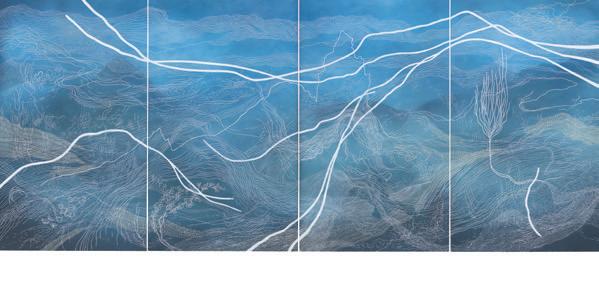
76 cm x 180 cm
Unique State
I am continually drawn back to Lake Sorell on the Central Plateau of Tasmania to listen deeply to the ‘silence’ this landscape emits. This environment is layered in history and memory, geologically and culturally, and in the more current experiences and emotions I bring to its shores.
It is there, that I can collect my thoughts.
Anne Starling
Aftermath, 2023
Linocut, woodblock, collage on BFK Rives
54 cm x 118 cm
Artist’s Proof 1/7
Aftermath is an examination of the barren landscapes created from the accumulation of man-made waste. The work makes reference to recent events, where natural disasters created vast wastelands of refuse and debris. The panel is carved in lino and integrates a range of print mediums layered with a collaged background consisting of a blended woodblock print. ‘Aftermath’ comments on the environmental legacy and addresses the implications of ruined environments for succeeding generations.
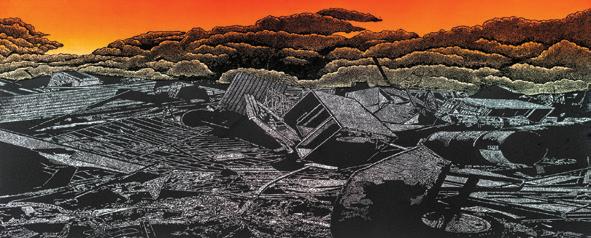 Elmari Steyn
Elmari Steyn
Maiden’s Voyage: The Wake Song I, 2022
Hard and soft-ground etching, stage-bite and burnished aquatint, 23k gold-leaf with chine-collé and hand-colouring.
76 cm x 224 cm
Unique State
This work is a Story Song that can be told most gracefully on paper. Engraved and printed, using multiple found and hand-cut copperplates, it reads from right to left. Through the use of layering, on various types of Japanese paper, laminated onto BFK paper, overprinted, ghost-printed, embossed and written upon; it draws out each image, colour-tone and fragment of memory, to reveal the deeply felt passing of a small child, to render the grace of the women at the wake and to convey the rhythm of the song.

Bridgit Thomas Cement Carriers, 2022

Etching, drypoint
80 cm x 61 cm
Edition 9/10
Constant maritime traffic on the bay flows onto my work and recent works consisting of everyday marine traffic, of which the cement carriers, feature strongly. These differ from the regular routine Container ships with their busy constructions and complex infrastructures and general monotone greyness. I am lured into their intense detail of metal madness and try to make relevance of all the confusion & chaos on deck. Drawing and printmaking, especially drypoint is the perfect medium for such an industrial image. In my print, I like to identify and compare the differences of individual Cement carriers that come in and out of Port Phillip Bay.
Peter Ward
The Last Great Industrial Heartland
_ green_ 2nd version, 2023
Hand coloured linocut
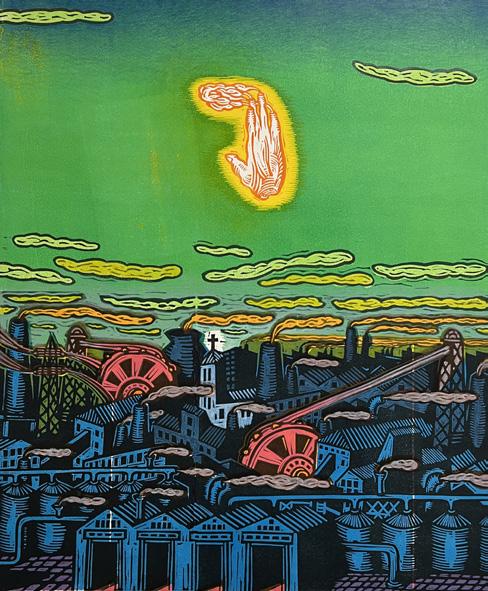
60 cm x 49 cm
Unique State
‘The Last Great Industrial Heartland’ continues my pre-occupation with the symbolic industrial landscape and tension between William Blake’s ‘dark satanic mills’ and admiration for human endeavour writ large. There is the Boy’s Own fascination with things industrial versus the knowledge of the irreparable damage caused.
Kylie Watson
The Day of the Dead, 2022
Linocut
45 cm x 300 cm
Unique State
My practice reflects on the themes of grief and loss and how these visually impact on my body which is the motif within my work. As a printmaker I create finely detailed, and intricate linocuts which inform the visual narrative of my artist books. These prints are handprinted and overlaid with textures which are boldly torn, stitched and hand sewn to recreate a new entity, with the scars of its recreation on show.
This execution of a print-based work shifts within its folded landscape and conveys a sense of movement both towards the narrative and is mirrored within its scroll formation. The paper is the sensitive element that connects the printed surfaces and their binding and is implicit of a delicate fabric. Intersected by textual elements this scroll book represents my reflection on how memories impact within the landscape of my heart.

Cleo Wilkinson
Encounter, 2022
Mezzotint print

52 cm x 46 cm
Edition 7/40
I try to emphasize the singularity and silence of a form - what is missing in the shadows provides the greatest potential for me. I love nursing the life of an image out of its pitch black womb into hope - in the form of light - the process has a primordial spiritual magic. The Mezzotint Print technique and tools have largely remained unchanged for the last 300 years. The process achieves tonality by roughening the metal plate with a metal tool, a rocker. The small teeth of the rocker create tiny burrs that hold ink during the printing process. The rocked areas that are left will produce a rich black print, areas that have been burnished (knocking the burrs down) will hold less ink, producing lighter values. This process produces an image with a high level of tonal richness.
Naomi Zouwer
Long Days #1, 2022
Screenprint
76 cm x 56 cm
Edition 4/8
Printer - Alex Lundy
As an artist who works across disciplines, I am interested in the way inanimate objects call to us, appealing to our senses and inviting us to appreciate their materiality and particular charms - pattern, colour, texture or story. Within the historical field, I situate my practice in the tradition of still life, especially rhopography, which art historian Norman Bryson articulates is, “the depiction of those things which lack importance, the unassuming material base of life that ‘importance’ constantly overlooks”. I am interested in raising the value of ordinary objects.
During my Megalo Print Studio residency in 2021, I experimented with remaking my paintings and collages into lithographs and screenprints. I was interested to see what was lost and found in translation from one medium to another. I played with increasing and diminishing the scale of the prints and reduced the colour palette. My recent exhibition at Megalo showed the process of this working between painting and printmaking techniques in finished and unfinished works, fails and wins, studio experiments and the objects that ‘call me’.
‘Long Days #1’, CMYK screen print on paper, 76 x 56cm was initially developed during my residency at Megalo in 2021 and was subsequently printed by Alex Lundy to launch the new Megalo Editions in 2022. In Imprint magazine, Viva Hall wrote about the works, “Pieces of a favourite dress, an outfit clipped from a magazine, and a silver ribbon: these objects form a nostalgic assemblage in the hands of Naomi Zouwer.”


BURNIE PRINT PRIZE
Burnie Art Gallery 77 – 79 Wilmot Street, Burnie, Tasmania P: 03 6430 5850 E: gallery@burnie.tas.gov.au www.burniearts.net Opening hours: Wednesday to Saturday 10am to 4pm
2023
 Cleo Wilkinson - Encounter
Cleo Wilkinson - Encounter












 Danielle Creenaune
Danielle Creenaune






 Dianne Fogwell
Dianne Fogwell









 Dr Nicola Hooper
Dr Nicola Hooper


 Lea Kannar-Lichtenberger
Lea Kannar-Lichtenberger






 Monika Lukowska
Monika Lukowska










 Helen Mueller
Helen Mueller









 Elmari Steyn
Elmari Steyn






